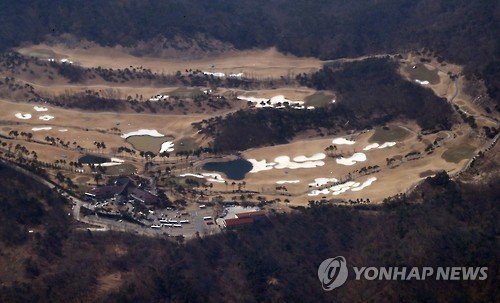South Korea has begun an environmental impact assessment of a local golf course ahead of the deployment of an advanced US missile defense system there, the military said Thursday, speeding up the deployment amid growing threats from North Korea.
The defense ministry picked a firm in December to conduct the assessment of the site in Seongju in the southeast, which will host the Terminal High Altitude Area Defense system. Late last month, the company began looking into the location to see if THAAD will affect the environment, farming and the health of nearby residents, a ministry official told Yonhap News Agency.

Lotte Skyhill Country Club, a golf course selected to host the THAAD system. The initial construction work is underway. (Yonhap)
"As North Korea rapidly improves its nuclear and missile capabilities, Seoul and Washington have stepped up efforts to complete the THAAD installation as quickly as possible," he said.
On Feb. 28, the defense ministry and Lotte Group signed a land swap deal, paving the way for an earlier-than-expected deployment of a THAAD battery in South Korea. In November, the US Forces Korea expected to finish the deployment between June and August.
Lotte agreed to hand over its golf course worth 89 billion won ($79 million) in Seongju in exchange for state-owned military property east of Seoul.
The process to deploy the THAAD system began last week. Two missile launchers and other equipment arrived at US Osan Air Base in Pyeongtaek, 70 km south of Seoul.
"The radar system for THAAD and other remaining elements will be delivered to South Korea soon or later (within this month) and undergo an operational test before deployment," the official said, dismissing reports that the radar system will arrive on Thursday.
The deployment could be completed within one or two months, and it can be operational as early as April, military officials said.
The personnel needed to deploy the THAAD elements in Seongju and carry out a test run are expected to come from THAAD units in Guam and Fort Bliss, Texas.
A THAAD battery consists of six truck-mounted launchers, 48 interceptors (eight per launcher), a fire control and communications unit, and an AN/TPY-2 radar. THAAD is designed to intercept short and mid-range missiles, such as Scud and Rodong, which have a range of up to 3,000 kilometers at altitudes of 40-150 kilometers.
Seoul and Washington have said the system is purely defensive and poses no threat to other countries in the region. But China has opposed it, arguing the system's powerful radars could spy on its flights and missile launches.
In July last year, Pyongyang's continued provocations apparently provided a strong impetus for the allies to agree to deploy the THAAD system in South Korea by the end of 2017. (Yonhap)

![[AtoZ into Korean mind] Humor in Korea: Navigating the line between what's funny and not](http://res.heraldm.com/phpwas/restmb_idxmake.php?idx=645&simg=/content/image/2024/04/22/20240422050642_0.jpg&u=)
![[Exclusive] Korean military set to ban iPhones over 'security' concerns](http://res.heraldm.com/phpwas/restmb_idxmake.php?idx=645&simg=/content/image/2024/04/23/20240423050599_0.jpg&u=20240423183955)



![[Graphic News] 77% of young Koreans still financially dependent](http://res.heraldm.com/phpwas/restmb_idxmake.php?idx=645&simg=/content/image/2024/04/22/20240422050762_0.gif&u=)